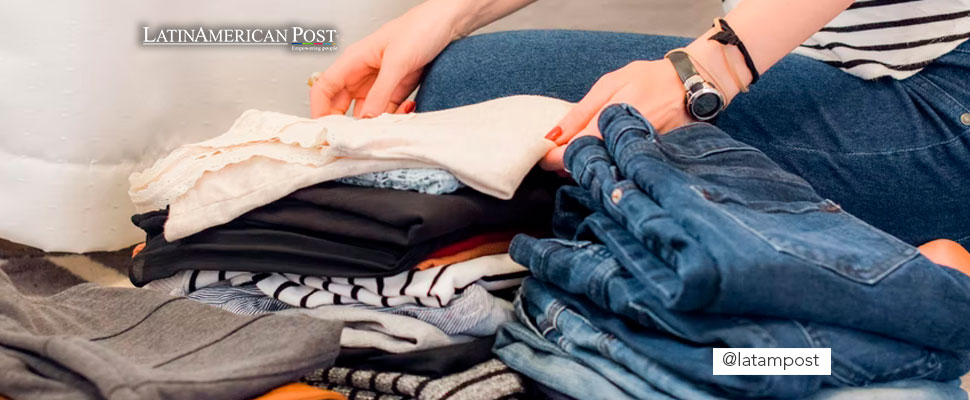Do You Know Where Your Clothes Come From?
Whether it is fast fashion brands or big name brands, the fashion industry is one that has a problematic production route. Here we tell you where your clothes come from .

When we talk about clothes we must bear in mind that the garments that come our way, and those that we only see on prestigious catwalks, have a whole production process. Photo: Unsplash
LatinAmerican Post | Vanesa López Romero
Listen to this article
Leer en español: ¿Sabes de dónde viene tu ropa?
The fashion industry is known to be one of the most profitable and ostentatious in the world. However, it also hides a destructive and harmful production line both for human life and for the environment. When we talk about clothes we must bear in mind that the garments that come to our hands, and those that we only see on prestigious catwalks, have a whole production process in which different factors must be taken into account, such as natural, and human resources.
The hunger for raw materials
Natural fabrics come from plants and animals, some examples of fabrics from animals are silk, wool, cotton, and linen. On the other hand, artificial or synthetic fabrics are made from raw materials, usually cellulose. Other synthetic fibers like polyester and nylon are made from chemical processes. The skin of some animals is also used for materials such as leather. This implies, on the one hand, that animals are raised for these purposes. In most cases, behind this are cases of animal abuse.
In addition, tons of water, hectares of land, and large amounts of chemicals are used for planting the plants to facilitate the growth of the raw material. The foregoing is also necessary for raising animals that are used for the creation of fabrics, also taking into account that the food of these animals also derives from plants grown in the same way.
Also read: Brazil: From being the Lung of the Planet to a Global Environmental Concern
Initially we can point out that the environment is directly affected by this. But it should be noted that the creation of garments also affects human health. Either by the chemicals that are dumped into water sources vital to human life or by the territories taken to create these raw materials. The environment and humans, especially the most vulnerable communities, will be affected by this.
Proof of this is "Supply Change", the most recent report published by SlowFactory, an NGO that focuses on reviewing the consequences that exist behind the production of the textile and fashion industry. In this case, the report identified several renowned clothing brands that are part of a long list directly associated with deforestation in the Amazon, a region in Latin America that has been recognized as the lung of the world.
In this case, what happens is that the brands choose suppliers who produce the raw materials in places that have been deforested to raise animals and grow crops in order to produce these materials. In the Amazon, deforestation potentially grows over time and it is becoming increasingly clear that this region, once considered untouchable, is now home to both legal and illegal production.
The maquilas and slavery
Since fast fashion began to be judged by different social sectors for the way in which employees who are often hired by third parties are treated, brands around the world have sought to create campaigns to divert attention. Most are focused on being sustainable and responsible brands with the environment. But we must remember that humans are also directly affected by these types of industries.
In this case, the maquilas workers live from day to day and make a living with the little they earn in the factories, making clothes that will later be sold by the brand at a much higher value than it cost to produce. Despite the fact that these cases have been exposed, there are still many brands that hide behind these methods and that do not give guarantee to those who work for them.
This has even crushed the lives of thousands of workers, who have had to be in the collapse of buildings that function as factories and that have been threatening to fall for years. The political regulations that exist for this are null in developing countries, of which the richest and most developed countries take advantage.
To the changing room and then to your closet
On the other hand, for those clothes that are made in Asian countries to reach your closet, it must travel thousands of kilometers. For this, there needs to be transport, which of course is not sustainable and produces tons of greenhouse gas emissions. To this must be added the energy that is expended in this process and that expended in the hundreds of warehouses that receive thousands of voracious customers for more and more garments.
As we can see, for a light to reach your closet it is necessary that it first go through a process that puts the environment, the lives of others and, eventually, your own life at risk.
The saddest thing about this? Every year tons of clothes are thrown away, showing us that behind this there is nothing more than an insatiable desire for exaggerated consumption.
What can you do?
The first thing is to learn to identify those brands that you should not go to when buying your clothes. Also, look for other purchasing methods.
- Buying second-hand clothes is very fashionable since there is a nostalgia for vintage
- Buying local clothes and supporting ventures that are just starting up is a very good option.
- Take good care of your clothes so that they can have a longer useful life and in the long run you can sell them or exchange them with someone else




